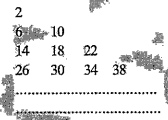Look at the pattern of squares made by sticks of same length.'(##VPU_TTT_MAT_X_P01_C01_E03_Q01)
(VPU_TTT_MAT_X_P01_C01_E03_009_Q02##)'
i) Write the sequence of the number of sticks.in each.
ii) Is the sequence of the number 'of rectangles including squares in eạch figure an arithmetic sequence?Solution in Malayalam
Step by step video & image solution for Look at the pattern of squares made by sticks of same length.'(##VPU_TTT_MAT_X_P01_C01_E03_Q01)(VPU_TTT_MAT_X_P01_C01_E03_009_Q02##)' i) Write the sequence of the number of sticks.in each. ii) Is the sequence of the number 'of rectangles including squares in eạch figure an arithmetic sequence? by Maths experts to help you in doubts & scoring excellent marks in Class 10 exams.
Updated on:21/07/2023Topper's Solved these Questions
Similar Questions
Suppose we draw circle with the bottom side of the. triangles in the picture as diameter. Find out whether the top comer of each triangle is inside the circle, on the circle. or outside the circle.
'(##VPU_TTT_MAT_X_P01_C02_E01_001_Q01##)'
View SolutionThe correct order of polarizability for I−,Br−,CI−,F− is :
View SolutionCl−,Br−,I− के डाईहैलोजन में ऑक्सीकृत होने का सही क्रम है
View SolutionF, CI, Br और I जिनकी परमाणु संख्याएँ क्रमश: 9, 17, 35 और 53 हैं, एन्थैल्पी का सही क्रम है :
View Solutionनिम्नलिखित अम्लों की प्रबलता की सही क्रम है
(i) CH3CH2CH2COOH
(ii) CH3CH2CH(Br)COOH
(iii) CH3CH(Br)CH2COOH
(iv) (CH3)2CHCOOH
View SolutionCheck whether each of the sequences given below is ah arithmetic sequence, give reaśons. For the arithmetic 'sequences, write the common difference also. i) Sequence of natural numbers ii) Sequence of multiples of three iii) Sequence of prime numbers, iv) Sequence of square numbers v) Sequence of powers of three
View SolutionConsider an arithmetic sequence with first term 18 and common difference 3.
i) Write the terms of this sequence.
ii) Write the perfect square terms of this sequence. Check whether it is an arithmetic sequence.
View SolutionConsider 'the arithmetic sequence 10,17,24,…. i) What is its algebraic form? ii) Prove that there is no perfect square in this sequence.
View SolutionConsider the arithmetic sequence 17,20,23,26,….. a) Write the algebraic form of this sequence. b) Is 400 a term of this sequence?. c) Is the square of any term of this sequence belongs to this sequence? Why?
View SolutionLook at these pictures: If the pattern is continued, do the numbers of coloured squares form an arithmetic sequence? Give reasons.

View SolutionSee the pictures below: How many small squares are there in each rectangle? Continuing this pattern, is each such sequence of numbers, an arithmetic sequence?

View SolutionSee the pictures below: How many large squares? Continuing this pattern, is each such sequence of numbers, an arithmetic sequence?

View SolutionSee the pictures below: How many squares in all? Continuing this pattern, is each such sequence of numbers, an arithmetic sequence?

View SolutionA pattern is formed using sticks of equal length as shown below:
 . Write the sequence of number of sticks used in each figure.
. Write the sequence of number of sticks used in each figure.
View SolutionA pattern is formed using sticks of equal length as shown below:
 . Write the sequence of number of squares and rectangles in each figure.
. Write the sequence of number of squares and rectangles in each figure.
View SolutionObserve the number pattern made using terms of an arithmetic sequence 2, 6,10, ...
 . Write the next two lines.
. Write the next two lines.
View Solution
